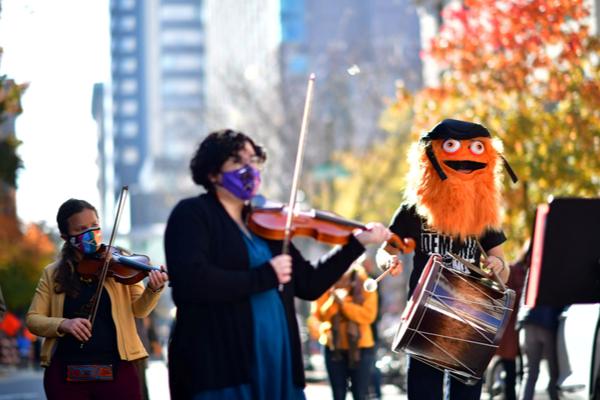Stop Rumors, Stop Violence: How Unarmed Protectors Keep Us Safe
Link to source: Here
 A band featuring Gritty, the Philadelphia Flyers hockey team mascot, plays across the street from where ballots are being counted in Philadelphia on Nov. 6, 2020. REUTERS / Mark Makela
A band featuring Gritty, the Philadelphia Flyers hockey team mascot, plays across the street from where ballots are being counted in Philadelphia on Nov. 6, 2020. REUTERS / Mark Makela
As this uncertain post-election period continues in the United States, we must be prepared to help calm communities, prevent violence, and protect each other through disciplined and strategic nonviolent action.
I work with Nonviolent Peaceforce, an international non-governmental organization. Our mission is to protect civilians facing violent conflict through unarmed strategies, while building peace alongside local communities. We have worked in conflict-affected contexts around the world, including in South Sudan, Iraq, Sri Lanka, and Guatemala. Though the U.S. is rarely identified as a “conflict zone,” it is no surprise to experienced peacebuilders that the U.S. has reached its current boiling point.
The events we have seen in the U.S. are alarmingly close to early indicators of post-election violence we have observed in other contexts. This includes:
- the massive sale of guns and ammunition
- the presence of non-state armed actors and militias
- the privatization of services and dismantling of institutions
- the widening of the wealth and social service gaps
- deep entrenchment of identity politics
- the dehumanization of political opponents
- and open violence mixing with politics
In light of these indicators, we are witnessing nonviolent grassroots responses at a pace never before seen in the U.S.
In the months and weeks leading up to the election, Nonviolent Peaceforce worked in a broad-based coalition to train groups of neighbors and civilians in nonviolent methods to protect vulnerable polling sites across Minneapolis and St. Paul. Hundreds of people created welcoming polling places, complete with food trucks, music, and art. While threats of voter intimidation came from a legal adviser for the Trump campaign who sought off-duty members of the Minneapolis Police Federation (the same federation that defends the murder of George Floyd) to “challenge voters,” Election Day still went smoothly overall.
But while Election Day is over, the need for disciplined nonviolence is not — especially while Trump and many Republican leaders continue to question the legitimacy of election processes and results. These unsubstantiated accusations of widespread voter fraud helped motivate thousands of Trump supporters to gather in D.C. this past Saturday to falsely claim that Trump had won the election. As night fell, violence broke out between protesters and counter-protesters.
Mediators Beyond Borders International has led the creation of the TRUST Network to issue early warnings of possible violence and create a mechanism for swift, nonviolent response. Choose Democracy has trained hundreds of people in how to stop a coup while signing up thousands to resist such power grabs. Dozens of Protect the Results events are scheduled throughout the country from now until inauguration day. DC Peace Teams and Cure Violence are offering de-escalation trainings. Hold the Line provides resources for actions between now and Jan. 20. All of these initiatives are part of a sophisticated movement to use disciplined nonviolence to protect our democracy.
These unarmed, civilian-led approaches to security aren’t new. Neither is the questioning of militarized security. But what is new is the number of people who are rethinking what makes us safe during post-election unrest and beyond.
For me and other unarmed, civilian, protection practitioners, the answer is clear: Engaged and proactive community groups are best positioned to ensure their own safety and security. These groups can act quickly and serve as interrupters who mitigate rumors and quell the sporadic incidents that can spark counterviolence. They can often address a problem before 911 is called.
And this work will not end when President-elect Joe Biden and Vice President-elect Kamala Harris take office. Even under a new administration, Black and Indigenous communities, as well as other communities of color, will remain vulnerable to state-sanctioned violence and targeted attacks from white supremacists. Moving forward, we must identify vulnerable populations, identify community-specific safety needs, and then work alongside these communities to implement creative and context-specific strategies. This could entail training unarmed civilian protectors and pressuring our newly elected leaders to fund nonviolent, community-based approaches to security.
As the new administration considers these proposals, we hope they will remember that nonviolent civilians helped maintain the fair election that allowed them to secure their offices.

